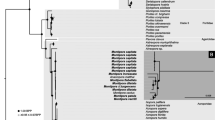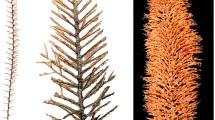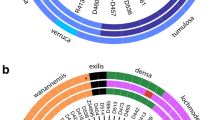Abstract
The Caribbean Acropora corals, A. palmata and A. cervicornis form a hybrid with two broad morphotypes, bushy and palmate. These morphotypes were previously hypothesized to be linked to the hybrid’s maternal species. Here, we expand on this hypothesis by adding samples from across the range and by increasing genetic resolution. We reconstructed complete mitochondrial genomes as a proxy for maternal species. This yielded novel A. palmata haplogroups, only one of which was shared by all three taxa. Experts then evaluated photographs to classify corals to a taxon based on colony morphology. Expert classification revealed less accuracy and confidence in hybrid, and surprisingly A. palmata identification compared to A. cervicornis. No association between the bushy morph and mitochondrial haplogroups was found when mapping hybrid morphotypes to the mitogenome phylogeny. Therefore, mitochondrial haplogroup membership is not predictive of Caribbean acroporid hybrid morphology across the range. Additional work is needed to uncover determinants of colony morphology.



Similar content being viewed by others
References
Bernt M, Donath A, Jühling F, Externbrink F, Florentz C, Fritzsch G, Pütz J, Middendorf M, Stadler PF (2013) MITOS: improved de novo metazoan mitochondrial genome annotation. Mol Phylogenet Evol 69:313–319
Budd AF (2000) Diversity and extinction in the Cenozoic history of Caribbean reefs. Coral Reefs 19:25–35
Budd AF, Johnson KG (1999) Origination preceding extinction during late Cenozoic turnover of Caribbean reefs. Paleobiology:188-200
Budd AF, Wallace CC (2008) First record of the Indo-Pacific reef coral genus Isopora in the Caribbean region: two species from the neogene of Curacao, Netherland Antilles. Palaeontology 51:1387–1401
Burton RS, Barreto FS (2012) A disproportionate role for mt DNA in Dobzhansky-Muller incompatibilities? Mol Ecol 21:4942–4957
Chen I-P, Tang C-Y, Chiou C-Y, Hsu J-H, Wei NV, Wallace CC, Muir P, Wu H, Chen CA (2009) Comparative analyses of coding and noncoding DNA regions indicate that Acropora (Anthozoa: Scleractina) possesses a similar evolutionary tempo of nuclear vs. mitochondrial genomes as in plants. Mar Biotechnol 11:141
Cowman PF, Quattrini AM, Bridge TCL, Watkins-Colwell GJ, Fadli N, Grinblat M, Roberts TE, McFadden CS, Miller DJ, Baird AH (2020) An enhanced target-enrichment bait set for Hexacorallia provides phylogenomic resolution of the staghorn corals (Acroporidae) and close relatives. Mol Phylogenet Evol 153:106944
de Lamarck J-BM (1816) Histoire naturelle des animaux sans vertèbres. Verdière, Tome second. Paris, p 568
Fogarty ND (2010) Reproductive isolation and hybridization dynamics in threatened Caribbean acroporid corals. [dissertation] Florida State University,
Fukami H, Iwao K, Kumagai NH, Morita M, Isomura N (2019) Maternal inheritance of F1 hybrid morphology and colony shape in the coral genus Acropora. PeerJ 7:e6429
Fukami H, Budd AF, Levitan DR, Jara J, Kersanach R, Knowlton N (2004) Geographic differences in species boundaries among members of the Montastraea annularis complex based on molecular and morphological markers. Evolution 58:324–337
Funk DJ, Omland KE (2003) Species-level paraphyly and polyphyly: frequency, causes, and consequences, with insights from animal mitochondrial DNA. Annu Rev Ecol Evol Syst 34:397–423
Goreau TF (1959) The ecology of Jamaican coral reefs I: species composition and zonation. Ecology 40:67–90
Goreau TF, Goreau NI, Goreau TJ (1979) Corals and coral reefs. Sci Am 241:124–137
Hatta M, Fukami H, Wang W, Omori M, Shimoike K, Hayashibara T, Ina Y, Sugiyama T (1999) Reproductive and genetic evidence for a reticulate evolutionary history of mass-spawning corals. Mol Biol Evol 16:1607–1613
Hemond EM, Kaluziak ST, Vollmer SV (2014) The genetics of colony form and function in Caribbean Acropora corals. BMC Genomics 15:1133
Huson DH, Bryant D (2005) Application of phylogenetic networks in evolutionary studies. Mol Biol Evol 23:254–267
Kitchen SA, Ratan A, Bedoya-Reina OC, Burhans R, Fogarty ND, Miller W, Baums IB (2019) Genomic variants among threatened Acropora corals. G3: Genes|Genomes|Genetics:g3.400125.402019
Kitchen SA, Von Kuster G, Kuntz KLV, Reich HG, Miller W, Griffin S, Fogarty ND, Baums IB (2020) STAGdb: a 30K SNP genotyping array and Science Gateway for Acropora corals and their dinoflagellate symbionts. Sci Rep 10:12488
Lanfear R, Frandsen PB, Wright AM, Senfeld T, Calcott B (2016) PartitionFinder 2: new methods for selecting partitioned models of evolution for molecular and morphological phylogenetic analyses. Mol Biol Evol 34:772–773
Letunic I, Bork P (2019) Interactive Tree Of Life (iTOL) v4: recent updates and new developments. Nucleic Acids Res 47:W256–W259
Liu S-YV, Chan C-LC, Hsieh HJ, Fontana S, Wallace CC, Chen CA (2015) Massively parallel sequencing (MPS) assays for sequencing mitochondrial genomes: the phylogenomic implications for Acropora staghorn corals (Scleractinia; Acroporidae). Mar Biol 162:1383–1392
Mao Y, Economo EP, Satoh N (2018) The roles of introgression and climate change in the rise to dominance of Acropora corals. Curr Biol 28:3373-3382. e3375
McNeill DF, Budd AF, Borne PF (1997) Earlier (late Pliocene) first appearance of the Caribbean reef-building coral Acropora palmata: Stratigraphic and evolutionary implications. Geology 25:891–894
Precht WF, Vollmer SV, Modys AB, Kaufman L (2019) Fossil Acropora prolifera (Lamarck, 1816) reveals coral hybridization is not only a recent phenomenon. Proc Biol Soc Wash 132:40–55
Ronquist F, Teslenko M, Van Der Mark P, Ayres DL, Darling A, Höhna S, Larget B, Liu L, Suchard MA, Huelsenbeck JP (2012) MrBayes 3.2: efficient Bayesian phylogenetic inference and model choice across a large model space. Syst Biol 61:539–542
Schliep KP (2011) Phangorn: phylogenetic analysis in R. Bioinformatics 27(4):592–593. https://doi.org/10.1093/bioinformatics/btq706
Todd PA (2008) Morphological plasticity in scleractinian corals. Biol Rev 83:315–337
Toews DP, Brelsford A (2012) The biogeography of mitochondrial and nuclear discordance in animals. Mol Ecol 21:3907–3930
van Oppen M, Willis B, Van Vugt H, Miller D (2000) Examination of species boundaries in the Acropora cervicornis group (Scleractinia, Cnidaria) using nuclear DNA sequence analyses. Mol Ecol 9:1363–1373
van Oppen MJ, McDonald BJ, Willis B, Miller DJ (2001) The evolutionary history of the coral genus Acropora (Scleractinia, Cnidaria) based on a mitochondrial and a nuclear marker: reticulation, incomplete lineage sorting, or morphological convergence? Mol Biol Evol 18:1315–1329
van Oppen MJH, Catmull J, McDonald BJ, Hislop NR, Hagerman PJ, Miller DJ (2002) The mitochondrial genome of Acropora tenuis (Cnidaria; Scleractinia) contains a large group I intron and a candidate control region. J Mol Evol 55:1–13
Veron JEN (1995) Corals in space and time: the biogeography and evolution of the Scleractinia. Cornell University Press, Ithaca
Vollmer SV, Palumbi SR (2002) Hybridization and the evolution of reef coral diversity. Science 296:2023–2025
Wallace CC (1999) Staghorn corals of the world: a revision of the coral genus Acropora (Scleractinia; Astrocoeniina; Acroporidae) worldwide, with emphasis on morphology, phylogeny and biogeography. CSIRO publishing
Wolstenholme JK, Wallace CC, Chen CA (2003) Species boundaries within the Acropora humilis species group (Cnidaria; Scleractinia): a morphological and molecular interpretation of evolution. Coral Reefs 22:155–166
Acknowledgements
Funding for this project was supported by NSF OCE-1537959 awarded to IBB and NSF OCE-1538469/1929979 awarded to NDF. We thank Hunter Noren, Megan Bock, Leah Harper and Morgan Hightshoe for their assistance in-field photography of the Belize, Curacao and USVI samples. We thank Tyler Smith and Marilyn Brandt for facilitating field work in the USVI and Mark Vermeij for facilitating field work in Curacao. We also thank the participants listed in Table S5 for taking time to complete the survey. Samples from Belize are part of the Caribbean Coral Reef Ecosystems (CCRE) Program, Smithsonian Institution contribution #1046. Permits for samples include Florida: CRF permit numbers CRF-2017-009, CRF-2017-012, NOAA FKNMS permit numbers FKNMS-2011-159-A4, FKNMS-2001-009, FKNMS-2014-148-A2 and FKNMS-2010-130-A, Belize: CITES Permit 0385, 7487 and 7488; Curacao: CITES Permit 16US784243/9 and 12US784243/9; and USVI Department of planning and natural resources, Division of fish and wildlife DFW14017T.
Author information
Authors and Affiliations
Corresponding author
Ethics declarations
Conflict of interest
On behalf of all authors, the corresponding author states that there is no conflict of interest.
Additional information
Publisher's Note
Springer Nature remains neutral with regard to jurisdictional claims in published maps and institutional affiliations.
Topic Editor Peter Francis Cowman
Supplementary Information
Below is the link to the electronic supplementary material.
Rights and permissions
About this article
Cite this article
Kitchen, S.A., Osborne, C.C., Fogarty, N.D. et al. Morphotype is not linked to mitochondrial haplogroups of Caribbean acroporid hybrids. Coral Reefs 41, 829–836 (2022). https://doi.org/10.1007/s00338-021-02135-5
Received:
Accepted:
Published:
Issue Date:
DOI: https://doi.org/10.1007/s00338-021-02135-5




